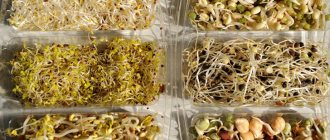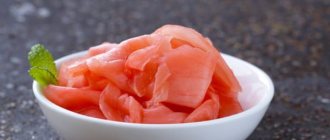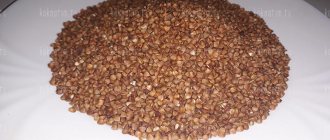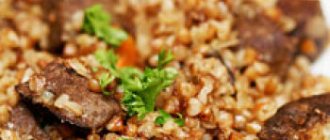How to germinate green buckwheat at home
Green buckwheat is sprouted due to its beneficial properties; in this form it is much more easily absorbed by the body with little energy expenditure during digestion. Sprouts are rich in protein and vitamin C. If we compare green sprouted buckwheat with regular buckwheat, then the former is undoubtedly more healthy.
But before you learn the rules of how to germinate green buckwheat at home, you need to learn how to choose the right grains for germination.
Perhaps the most important point is that you need to choose green buckwheat, because these grains cannot be heat treated, unlike fried brown or steamed buckwheat, they are still “alive”, and only they are capable of sprouting.
If you take the issue seriously and choose the right cereal, then germinating green buckwheat at home will not cause you any difficulties.
- It is optimal for germination to focus on high-quality cereals from the latest harvest, ideally if it is “organic cereals”, that is, an environmentally friendly place was chosen for sowing and no chemicals were used during the growing process;
- Autumn or spring is the most optimal time to germinate buckwheat at home;
- Carefully examine the grains: their integrity should not be compromised, and the color must be uniform green and beige;
- There is no obligatory condition for purchasing buckwheat in a store or on the market; the most important thing is that the grains are of high quality.
Before you start germinating green buckwheat at home, you will need to take the following steps:
- Choose the right dishes: try not to use plastic plates; it is better if you place the grains in a glass, porcelain or ceramic container.
- Select a shallow and wide bowl for soaking the grains;
- Be sure to rinse the cereal thoroughly, preferably rinse several times. Rinse as many times as necessary so that the water drained from the cereal is clear;
- Prepare clean water. This can be spring or filtered water;
- Find a piece of gauze or bandage.
How to properly sprout green buckwheat for food
After purchasing the “right” grains and completing the preparation stage, you can proceed directly to the most important and interesting thing - germinating buckwheat grains. The process is quite fascinating; at first glance, it seems labor-intensive, but in fact there is nothing complicated here; anyone can do it, even the inexperienced.
We have prepared for you a detailed description and described step by step how to properly sprout green buckwheat for food. So let's get started.
- Buy green buckwheat grains
. Only green and no other: ordinary cereals will never germinate and your expectations will be in vain. - Determine the required portion of cereal for germination
. There are absolutely no restrictions here, everyone calculates the serving size purely individually; note that it is best to germinate cereals with a small reserve (literally for 2-3 days), this will save you from the need to return to the germination process every day; - Very important!
You definitely need to wash the seeds, even if they look clean - this is not an indicator. It is advisable to rinse under running water at least three times. You can rinse the grains in a way convenient for you: under running water or pour in the grains and later remove those that have floated to the surface. - Next, you need to place the washed grains in the container where they will be germinated
. It is better to choose wide glassware - it is convenient to lay out the grains in one layer. - We should also talk about water
. For germination, you cannot take regular tap water; you need the water to be purified, but under no circumstances boiled. Pour clean water over the grains in the following proportion: pour three parts of water to one part of buckwheat. - Get ready to wait
. After about three hours, the grains will become twice their original size. That is why the dishes should be wide. If mucus starts to appear around the cereal, don’t worry, there’s nothing to worry about, you’ll just need to rinse the cereal again under water. - Have you decided to properly sprout green buckwheat for food?
Do not leave the seeds to swell for more than ten hours, otherwise an irreversible fermentation process will begin and such grains will have to be thrown away. They cannot be eaten. - Rinse the buckwheat after the first two to three hours of swelling
and spread it in a thin layer over the surface of the dish used for germination and cover with one layer of gauze. - Next, close the dish with a lid, but you don’t need to close it tightly, leave a flow of air, the grains should breathe
. Place the container in a warm place for about a day, and once every ten hours you need to rinse the cereal, but this must be done extremely carefully so as not to injure the sprouts. - When the set time has passed, you can notice small sprouts,
no more than two to three millimeters, which are optimal for consumption. - When the sprouts reach the desired length, you can remove them from the heat and put them in the refrigerator, which will stop the growth, or you can immediately start preparing your favorite dishes.
Before you germinate green buckwheat at home, carefully go through each of the outlined steps and prepare everything you need to realize your idea. Feel free to start germinating green buckwheat, and in just a couple of days (this is exactly the time period required for the grains to become as healthy and tasty as possible) you will be able to taste sprouted green buckwheat and fill your body with the beneficial elements it needs.
A quick way to germinate buckwheat
Pour well-washed green buckwheat with boiled water (for 1 cup of cereal - 3 cups of water) and leave for 1.5 hours. Then drain the water, rinse the cereal thoroughly under running water and dry a little, stirring. You can keep it in water longer - up to 12 hours, but no more, so that the fermentation process does not begin. With this soaking, the grains become covered with a large amount of mucus. Some raw foodists prefer buckwheat in this form, so they do not wash it. Those who do not like this mucus can get rid of it very easily. You just need to rinse the cereal thoroughly with plenty of water.
It happens that it is not always possible to wait for the required length of sprouts to appear, repeatedly washing and drying the cereal. In such cases, the method of how to germinate buckwheat in a short period of time will definitely come in handy.
Why do they sprout cereals?
Traditional fried buckwheat is very familiar to all ordinary people and often appears on the tables of average residents of our country. This product is very useful, but green buckwheat, which has not been subjected to heat treatment, retains the full composition of the components, which allows it to remain more effective for the body. Green buckwheat is better absorbed and provides a higher percentage of amino acids and vitamins , which is especially valuable for human health.
You can read more about the difference between brown and green buckwheat here.
Fans of a healthy lifestyle have found a way to make healthy green buckwheat even more effective. It is not boiled, baked, or steamed, but sprouted. Sprouting buckwheat at home means getting an original, healthy product, rich in vitamins and minerals.
The uniqueness of this cereal is due to the fact that during the germination process the grain activates its forces to awaken a new plant. It is this energy, along with useful substances, that needs to be consumed in food.
Unlike classic fried buckwheat, a sprouted green product is able to saturate, activate the metabolic process , and convey maximum benefits to the entire body.
Fasting days on sprouted buckwheat
The average human diet, as a rule, includes a lot of “non-living” thermally processed food and little fiber. There are few useful substances left in cooked food, and while digesting it, the body works hard to get the maximum benefit from the available food. The body has neither time nor energy left for deep cleansing actions at the cellular level - they are reduced only to the superficial removal of waste products from the body.
Often our body just needs a spring cleaning, so fasting days are considered very useful. What are the benefits of unloading on buckwheat sprouts? This method is suitable for active people. It will allow you to receive enough calories for normal life activities and will launch the body’s self-cleaning functions. “Live” grains stimulate the body’s toxin-removing functions, however, if the body is very polluted, then during fasting days unpleasant or painful sensations may appear:
- headache;
- joint pain;
- sweating;
- weakness;
- white coating on the tongue;
- smell from the mouth.
All these effects indicate cleansing of the body - the stronger the discomfort, the more slagged the body is. Therefore, when unloading (including on buckwheat sprouts), you should not take any medications and give the body additional physical activity.
Such fasting days are very useful for losing weight - thanks to the same cleansing and slag-removing effect, buckwheat sprouts help you lose extra pounds.
Different diets and nutrition systems recommend consuming different foods. Today there are so many of these systems that the only way to understand whether a food product is suitable for a particular person is to rely on sensations. Even very healthy green buckwheat may not be suitable - individual intolerance will arise or it will simply seem tasteless. Therefore, when introducing buckwheat sprouts into the diet, it is better to be consistent and moderate.
A look at buckwheat from a new angle
Buckwheat is known very well in our country. It is also grown in large quantities in China. From our continent it spread throughout the world and was loved everywhere for its excellent taste.
In order to restore a depleted body, poisoned by harmful food impurities, and polluted, we increasingly began to turn to the topic of healthy eating.
There is an opinion that healthy eating is either self-torture and torture, or a very expensive pleasure. Not at all. In this article we will talk about buckwheat, which is familiar to our taste, but we will look at it from a somewhat unusual angle and find out how to germinate green buckwheat and why it should be done.
Chemical composition and calorie content of sprouted buckwheat
The most useful green cereals are sprouted. Before growing buckwheat microgreens, you should familiarize yourself with its chemical composition. It is a collection of the most valuable elements for the body:
- complex carbohydrates,
- carotene,
- iodine,
- routine,
- lemon acid,
- Apple acid,
- vitamins K, E, B,
- zinc,
- copper,
- selenium,
- chromium,
- silicon,
- manganese,
- iron,
- phosphorus,
- calcium,
- potassium, etc.
Calorie content per 100 g - 290 kcal.
How to properly sprout green buckwheat for food
In order for grain germination to be successful and such a product to be suitable for consumption, it is necessary to select a high-quality seed, prepare the water, and then strictly follow the instructions. But in general, this is easy to do at home.
Grain selection
The choice of grain should be based on several criteria:
- Color . Should be soft greenish, without brown or bright green tints.
- Purity . Complete absence of any impurities (twigs, leaf fragments, stems, husks, small stones). Contamination of cereals is an enemy of quality. Before preparing food from such buckwheat, you will have to sort and wash it for a long time.
- Healthy look . If mechanical damage is found on the seeds, they will not germinate. The percentage of crushed or damaged grains should not be more than one.
- Smell . The presence of a musty smell indicates that live buckwheat has spoiled, and germinating or eating it can be hazardous to health. If there is no smell, it is recommended to taste the grain to make sure there is no bitterness or acidity.
- Size : Buy single bore cores.
Important! It is recommended to store the purchased seed in a closed container, which should be in a dark, cool room.
Water for germination
In order for buckwheat seeds to germinate well, you need to select high-quality water for them. It is better to take melted water, from a spring or filtered. Moisture will be absorbed by the grains and activate the process of revitalizing the seedlings. In this case, water will act as soil.
Instructions
The effectiveness of your work depends on how correctly you organize the procedure for germinating buckwheat.
Follow the following instructions:
- Take the required number of grains that you will germinate. So, from one cup of seeds you will get approximately 1.5 cups of the finished product. If you need more, increase the original rate.
- Wash the cereal thoroughly under running cool water for 2 minutes. This is necessary in order to get rid of excess starch.
- Place the washed green buckwheat in a glass container (preferably large) and fill it with water for 1.5 hours. There should be three times more water than seeds.
- After the specified time, drain the liquid and discard the seed that floats as it will not germinate.
- Rinse the cereal several more times. Do this until you have drained the clear liquid.
- Move the jar into the germination container. This can be a ceramic, glass or porcelain container with a wide bottom and always a lid.
- Close the container with the seeds tightly and send them to a warm place. After 5 hours, stir the cereal. The first shoots will appear after 8 hours. This is the average time indicator. Germination can take place after 12 hours or later. You should not be afraid that buckwheat will not sprout; this process may depend on varietal characteristics or temperature indicators.
Sprouts can be eaten after their length reaches 1 mm. But it’s better to do this after 2–4 days: such a dish will be the most delicious and healthy for the body.
Benefits of green buckwheat for sprouting.
Why green buckwheat? There are many reasons, I will list them in order of importance to me:
- Of all the grains that I have tried to germinate, green buckwheat seems to me the most delicious ! And I tried a lot of things: oats, rye, wheat, spelt, chickpeas, mung beans, peas. So, I am not a fan of forcing myself to eat foods because they are healthy and despite the fact that they do not seem tasty to me. In addition to buckwheat, I like the taste of mung bean sprouts and sometimes chickpeas (depending on my mood). But buckwheat is definitely in the lead by a wide margin)
- Green buckwheat is the easiest and fastest to germinate . Even the most notorious incompetent can germinate it))) And you don’t have to wait long for the first shoots to hatch!
- Green buckwheat is very well digestible. This information is not from books, but from my personal experience. After sprouted wheat, for example, I feel fermentation in my stomach. Same with peas and most legumes.
- Buckwheat does not contain gluten . By the way, maybe that’s why it’s absorbed very well by me. I do not have a pronounced gluten intolerance, but I know that it is poorly digested in all people, the only question is the degree...
- Buckwheat has a unique vitamin and mineral composition . It has a lot of protein and a very good composition of amino acids, minerals, and vitamins. A little later I will write a separate article about the benefits of green buckwheat)
- Buckwheat does not contain GMOs . Most grains have long been grown using the wonders of genetic engineering. This wave has not yet reached buckwheat. I also heard that buckwheat is not treated with pesticides, since bees love it very much, and if they stop pollinating buckwheat due to chemicals, then there will simply be no harvest next year. Maybe that’s why buckwheat germinates 100% of the time. But other grains and legumes are very capricious and may not germinate at all! Maybe it's because of the chemicals that they don't germinate?
Advantages
People who adhere to the principles of a healthy diet have long known about the unique vitamin and mineral composition of sprouted green buckwheat. 100 grams of “live” grain contains 67% of the daily value of thiamine (vitamin B1), 82% of vitamin E, 80% of zinc and many other important vitamins and microelements.
Other benefits of sprouted buckwheat:
- It is valued for its high content of protein balanced in amino acid composition - almost 20% of the daily value (for comparison, a grain of rice contains only 7% of the protein value);
- absence of gluten, due to which sprouted buckwheat grains can be consumed even by people who adhere to a gluten-free diet;
- “live” cereals contain 4 times more flavonoids than “dead” ones, due to which a high anti-cancer effect is achieved;
- despite its high calorie content, it promotes weight loss and is part of balanced diets;
- contains more fiber than other sprouted grains, which promotes excellent digestion;
- rich in various amino acids;
- does not accumulate harmful substances from fertilizers and is considered an environmentally friendly product.
Indications for use and benefits of sprouted green buckwheat
There is no consensus on who should eat sprouted green buckwheat. This product will be useful to almost everyone.
The following categories of the population need it most:
- People who are overweight. Buckwheat will help them reduce their appetite and help cleanse the body.
- Diabetics of all types. Sprouted buckwheat easily lowers blood sugar.
- People with weak immunity. The sprouts contain the most important antiviral vitamins: C and B. It also contains iron and magnesium, which have a beneficial effect on hematopoiesis.
- Those who have chronic metabolic disorders. Another unique property of green buckwheat sprouts is to improve metabolic processes in the body.
As for the benefits of the product, the range of possibilities of sprouted buckwheat is even wider.
I will name 9 of its most important properties:
- Saturation of the body with useful microelements, vitamins and fiber.
- Providing the body with energy.
- Active participation in the process of hematopoiesis, the fight against reduced hemoglobin.
- Rejuvenation of the body.
- Increasing endurance, helping the body during intense physical activity.
- Reducing blood sugar and cholesterol levels.
- Promoting brain function, improving memory.
- Treatment of diseases of the gastrointestinal tract.
- Strengthening blood vessels.
- Normalization of the nervous system, resistance to stressful situations.
Please note: you should start taking green buckwheat sprouts gradually, increasing the daily dose to 50 g. At first, taking sprouted buckwheat may cause discomfort, but this is not a reason to sound the alarm. Very often the body reacts this way to the introduction of a new product, and this is just an adaptation to it.
Another argument in favor of sprouted buckwheat
Does the product have contraindications?
Despite the fact that sprouted buckwheat is so healthy, it also has contraindications.
The main ones are increased blood clotting and stomach ulcers.
With such characteristics of the body, green buckwheat sprouts can be consumed only after consultation with a therapist or gastroenterologist.
And one more important point: green sprouted buckwheat is not recommended to be mixed with milk, honey or medicinal herbs.
The effect of using the product in this form can bring a completely different result.
6 steps to making rye porridge in your kitchen
Nutritional value of green buckwheat
Green buckwheat sprouts contain 18 amino acids, 9 of which are essential, and are the leader in the content of vitamins and minerals among cereal crops. They contain:
- vitamin PP;
- B vitamins;
- vitamin E;
- vitamin C;
- vitamin P;
- calcium;
- iron;
- phosphorus;
- zinc;
- iodine.
Green buckwheat is ideal for nutrition - it is easily digestible and saturates the body with slow carbohydrates. Thanks to its amino acid composition, sprouted buckwheat has extremely beneficial effects:
- prevents cardiovascular diseases;
- accelerates metabolic processes;
- restores the “correct” microflora in the intestines;
- protects blood vessels and prevents arthritis and osteoporosis;
- protects the immune system and strengthens skin, nails and hair;
- normalizes blood sugar levels;
- reduces cholesterol levels;
- improves the functioning of the liver and gall bladder.
Green buckwheat is universal - you can eat it as much as you want, combine it with all kinds of foods and add it to different dishes - cold and hot, salty and sweet. In addition, the balanced composition of sprouted buckwheat allows it to become a complete replacement for animal protein.
How to use
Sprouted green buckwheat can be consumed in its pure form or used as an ingredient in various dishes - cocktails, porridges, soups and salads.
Norms per day
A healthy person needs 5-7 tbsp. l. 1-2 times a day. For patients suffering from various diseases, the consumption rate is 5-7 tbsp. l. 3 times a day. On average, the dosage should be at least 100 g per day.
Green buckwheat as an alternative to meat
It has already been proven that any meat is more or less harmful to health, clogs blood vessels with cholesterol, is difficult to digest and even causes cancer. Although it has nutrients, whether they will be absorbed by the body is a big question. Sprouted buckwheat grains contain quite a lot of easily digestible protein, organic healthy fats and more than 70% carbohydrates. It is not without reason that it is called a superfood (from English “supereda”), such food charges you with energy for several hours and has no side effects.
The following is a table with the energy indicators of sprouted buckwheat and meat.
| Product name | kcal per 100 g | Proteins per 100 g | Fats per 100 g | Carbohydrates per 100g |
| Sprouted green buckwheat | 300 | 13 | 4 | 71 |
| Veal | 90 | 19,7 | 1,2 | |
| Beef | 187 | 18,9 | 12,4 | |
| Rabbit | 199 | 20,7 | 12,9 | |
| Mutton | 203 | 16,3 | 15,3 | |
| Medium fat pork | 320 | 16,4 | 27,8 |
This is interesting
The famous American doctor, nutritionist and star trainer Douglas Graham determined the optimal percentage ratio of carbohydrates, proteins and fats for a person as 80/10/10. In his book “The 80/10/10 Diet,” he wrote that modern standards for protein consumption are greatly overestimated, and in order to maintain the functioning of organs and muscles, an adult needs a large amount of high-quality carbohydrates. If this statement is true, then green buckwheat has a good chance of displacing meat and taking center stage on dinner tables.
Water is only of the highest quality
Choose the best water you can find. It should not be boiled - the grain will germinate in it, but it will not be at all as healthy as the one that sprouted in the raw. This is explained by the fact that boiled water is “lifeless”, depleted. There is a pronounced deficiency of oxygen in it, and for oxidative processes a living organism, that is, our nascent plant, needs it vitally. The sprout will feed on the liquid. Healthy water will ensure healthy seedlings. It’s good if it is structured, that is, spring, melt or glacial. If you don’t find one, take a bottled one and pass it through a good filter or freeze it in the freezer of the refrigerator.
Sprouted green buckwheat is delicious!
The initial enthusiasm of a researcher and adherent of a healthy lifestyle may fade somewhat after the appearance of sprouted buckwheat in the refrigerator. Of course, such porridge is tasty in its original form, but a few days pass and simply sprouted cereal no longer evokes joy, and its benefits seem not so significant, especially against the backdrop of a lack of appetite.
Experts note that at this stage of introducing such a useful product into your diet, it is important not to give up, but to choose recipes that will help reveal the taste qualities of this cereal as fully as possible. Knowing how to properly prepare sprouted cereals, you can be sure of a good appetite for all household members.
The ideal breakfast with sprouted buckwheat is porridge with fruit . The grains can be poured with milk (cow's or vegetable), generously add fruit, a little honey for sweetness, sesame or poppy seeds for effect. And the mass, ground with dried fruits and coconut oil, can replace cottage cheese, becoming an excellent addition to a hearty breakfast.
For lunch, sprouted buckwheat can be consumed in the form of popular, healthy cocktails - smoothies . To do this, grind the cereal in a blender with seasonal fruits, a liquid base (water, coconut or oat milk), add honey and dates for sweetness. The smoothie can also be salty if you add avocado, zucchini or spinach to the grain base.
A delicious lunch with sprouted green buckwheat is a balanced salad with seasonal vegetables : for example, cucumbers, tomatoes, carrots, peppers, zucchini, cabbage and always greens - spinach, cilantro, dill, arugula, lettuce. For dinner, grains can be served as a separate dish, adding stewed or grilled vegetables.
Read more wonderful recipes in this article!
Healthy eating enthusiasts dry the sprouted grains and grind them into flour . This basis for pancakes, pies, pancakes makes them extremely useful for humans. Bread is baked from such flour, which ideally replaces the unhealthy yeast loaf from the store.
Even if you are not yet ready to completely remove unhealthy foods and dishes from your diet, sprouted buckwheat can take its place in your diet. This healthy and tasty cereal will be the first step towards healthy eating and well-being!
Where to buy green buckwheat for germination? What is the price? How to choose?
I buy green buckwheat for sprouting in online health food stores or at vegan fairs, which are held in Moscow more and more often... There is no point in buying any special buckwheat. It is approximately the same for all manufacturers and, as I already said, any green buckwheat germinates well. The main thing is that it is exactly green buckwheat, as indicated on the package. The fact is that the brown buckwheat we are used to will never grow, since it is the same green buckwheat, only processed many times - drying at high temperatures, steaming, frying. But green buckwheat is a grain in its original, natural form.
By the way, I don’t advise you to cook green buckwheat as a side dish. Of course you can try it, but it’s not tasty. After this, you may be disappointed and will no longer want to germinate green buckwheat)
Green buckwheat is not expensive. Everyone can afford it! For example, a year ago I bought a 10 kg bag for only 1000 rubles. Now it costs more - I saw the price around 700 rubles. for 5 kg, that is, 140 rubles/kg. If you buy in small quantities, 1 kg each, the price will be even slightly higher - about 170 rubles / kg.











